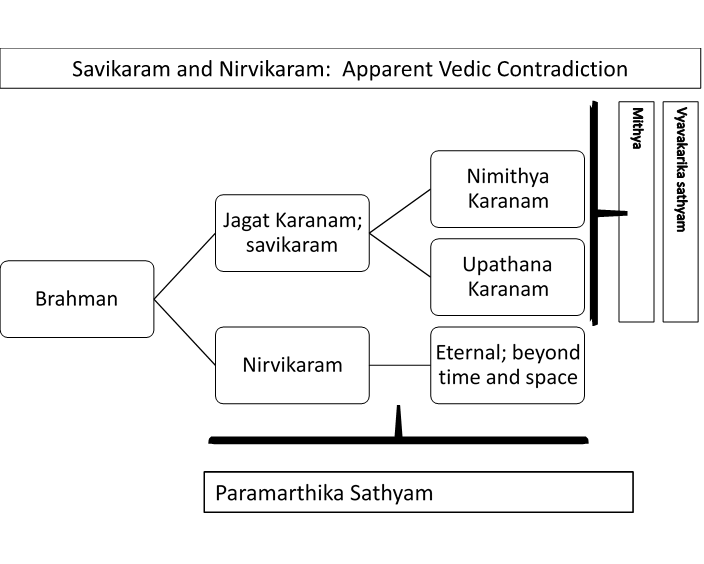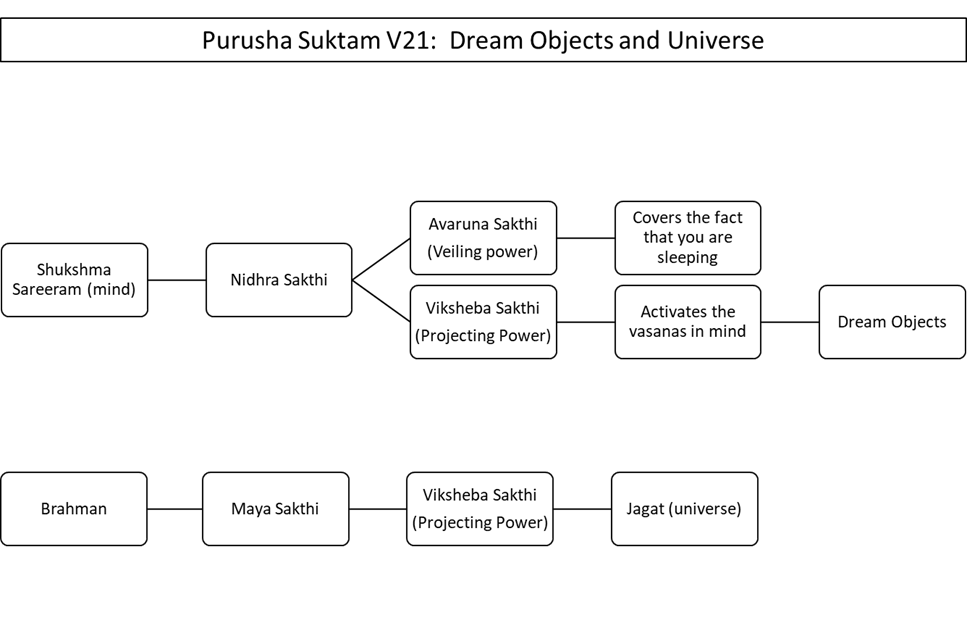Mandukya Upanishad, Class 43
Gowdapadha has established that nondual
Brahman alone is there, and this Brahman was non dual, is non dual and it will
ever be non-dual. If there is any duality, it is mithya. From 31st
verse onwards Gowdapatha wants to talk about samsara and its remedy.
Cause of samsara is missing advaidam which is sathyam and taking mithya dwaidam
as sathyam.
- Not having advaida dharshanam and remaining only in
dvaida dharshanam is the cause of samsara. - Running after is pravirthi and running away is nivirthi
and this is one root of samsara. - As long as I see duality, there is limitation by desa
and kala; As long as there is time and space limitation there will be
mortality and there will be insecurity and samsara; raga dwesha is
samsara. Punarabi jananm and puranabi maranam is samsara.
Whatever is the cause of samsara the
root cause is lack of advaida dharshanam. In sushukthi there is no
duality and there is no samsara. From this conclude that wherever there
is duality there is samsara. This dwaida dharshanam happens when only
when the mind is active. In Jagradha avastha and Swapna avastha there is
dwaida dharshanam. The dwaida dharshanam happens only in mind and mind is
the cause of samsara. If you tackle the mind, samsara is tackled.
This entire dualistic world charam (moving, living) and acharam (stationary and
not living) is presented by the mind. Mind alone imports dwaida prabanja
for me. By introducing dwaida prabanja, mind is introducing
samsara. So, if you want to tackle samsara, tackle mind. When the
mind is resolved, (mano nasaha) or negated or eliminated one will not have
duality. This is proved by our sleep state. The goal should be mano
nasaha or elimination of mind. How do you bring this about?

Verse 32
Mano nasaha is a confusing word if
it is taken literally. Mano nasaha is not physical destruction of mind,
but it has philosophical meaning. Understanding mind as mithya is mano nasaha.
Manomaya is anatma and mithya and does not have reality of its own.
Falsification of the mind is mano nasaha; there is no substance called mind
separate from atma. This is figuratively called destruction of
mind. Similar to vedantic destruction of pot. You can destroy the
pot by knowledge by understanding there is no substance called pot.
Reducing pot into non substantial nama roopa is called destruction of
pot. After this, you only say clay was, clay is, and clay will be the
pot.
By knowing there is no substance
called universe, but only one substance called atma. Universe is non substantial
nama roopa. This understanding of universe as non-substantial nama roopa
is called destruction of the world. Within the world, there is mind
also. When you reduce world to non-substantial nama roopa, mind is also
included. Mind is also a non-substantial nama roopa. This
understanding mano nasaha.
When you “destroy” the
pot, you continue to handle pot. Similarly, a gyani continues to negate
the world, but there is no cessation of perception of knowledge of world.
Gyani will continue to use the mind, body, world and he will say there is no
such called mind, body and world but only one substance called atma. This
must be very clearly understood. Many people think that a gyani has
physically destroyed mind.
- Mind should not be destroyed; If liberation is
destruction of mind, all liberated people will be without mind; then there
will be no difference between a liberated person and a rock. Then you
can’t talk about virtue of love, compassion. If gyani’s mind is
destroyed, all people with mind will be agyani that will include gurus. - The mind can’t be destroyed; Mind can’t be destroyed
because mind has there since creation; and death does not destroy
mind. Mind can’t be physically destroyed. - Mind need not be destroyed. Vedanta repeatedly
declares, everything other than atma is mithya. A mithya vasthu does
not really exist. Why should I try to destroy an unreal mind?
Rope snake need not be destroyed. You don’t need to anything other
than understand it is unreal, no other effort is needed to destroy the
rope snake.
Just understand mind is mithya and
this understanding is figuratively called mano nasaha. You don’t attack
the dream world; you just wake up to waker nature; the dream world
automatically collapses. Don’t struggle to destroy the mind; just know
the sathya atma which is the content of mithya mind. Just like sathya
clay is the content of mithya pot.
Knowledge does not take place
automatically. If you remove the thought, previously you are thoughtfully
ignorant, and now you are thoughtlessly ignorant. Guru sathraa upadesham
is required. When this takes place, the ignorant mind is converted to a
wise mind; an enlightened mind through knowledge. A wise mind perceives
dwaidam but knows it is mithya; just like sun rise and sun set are mithya, but
we still keep calling it sun rise and sun set. A wise mind that does not
see duality is as good as no mind, because it can’t cause samsara. At the
time of wisdom, the mind becomes non mind. Since perceived duality is
negated, the mind is a non-perceiver mind. It is a perceiver at the same
time it not a perceiver because it does not see any duality as real.
Verse 33
In this verse, Godwapadha discusses
uniqueness of atma gyanam; this is different from any other worldly
gyanam. In other knowledge subject, object and instrument distinction;
prmadha (subject) premayam (object) and the knowing instrument (pramanam)
thrupudi is there. In atma gyanam, the subject and object both happens to
be thuriyum, me, I am the knower and I am the known. What is the
instrument of knowledge; the atma itself is the instrument of knowledge.
We don’t require any other external pramanam because everything else is illluminated
by atma. Atma knows itself by itself; I know myself by myself. I am
the subject; I am the object and I am the instrument. There is no
thirupudi. I am self-evident.
If atma reveals by itself, then what
is the role of guru and sasthra? Guru and sathra are not required to
reveal atma. Atma is ever experienced and evident; it is the nature of
consciousness.


